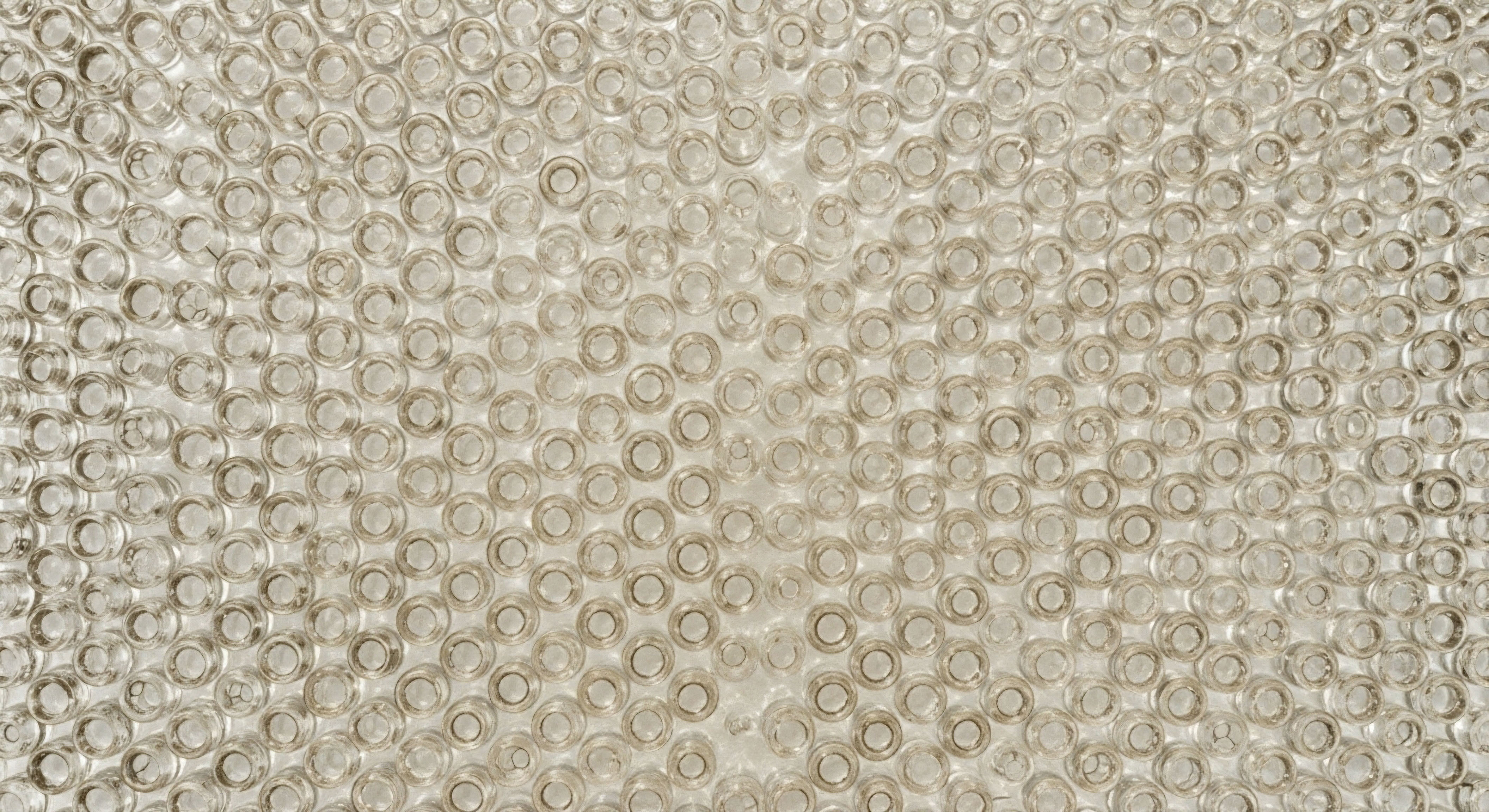

Fundamentals
The persistent feeling of being unwell, a fatigue that sleep does not seem to mend, or a subtle shift in your body’s resilience can be the first communication from your endocrine system that its internal balance is strained. This experience is the starting point for a deeper investigation into your own biology.
The question of whether lifestyle alone can recalibrate this intricate network is a profound one. The answer begins with understanding the system itself. Your body operates on a complex web of chemical messengers called hormones, a system designed for precision and stability.
This network, the endocrine system, governs everything from your energy levels and metabolic rate to your mood and reproductive capacity. It functions as a finely tuned orchestra, where each instrument must play its part in perfect concert with the others.
Lifestyle choices are the conductors of this orchestra. The foods you consume, the way you move your body, the quality of your sleep, and your response to stress are not passive activities. They are direct inputs, powerful signals that provide the endocrine system with the information it needs to maintain equilibrium, a state known as homeostasis.
When these signals are consistent, appropriate, and aligned with your body’s biological needs, the system can function with remarkable efficiency. This is the foundation of endocrine health, a state where vitality and function are optimized through conscious daily practices.

The Four Pillars of Endocrine Signaling
To understand how to restore function, we must first appreciate the mechanisms through which lifestyle exerts its influence. Four key areas provide the primary inputs to your hormonal command centers. Each one is a powerful lever for influencing the biochemical conversations happening within your body every second of the day.

Nutrition the Building Blocks of Hormones
Every hormone in your body is synthesized from raw materials you provide through your diet. Steroid hormones, including testosterone and estrogen, are derived from cholesterol, a lipid molecule. This means that adequate intake of healthy fats is a non-negotiable prerequisite for their production.
Insufficient dietary fat or severe caloric restriction can send a powerful “scarcity” signal to the hypothalamus, the master regulator in the brain, potentially downregulating reproductive and thyroid function as a survival mechanism. Similarly, proteins are broken down into amino acids, which are the precursors for thyroid hormones and neurotransmitters that modulate pituitary function.
Micronutrients like zinc, magnesium, and B vitamins act as essential cofactors in the enzymatic reactions that build these hormones. Your plate is quite literally the pharmacy from which your body sources the foundational components of its own internal medicine.
The foods you eat provide the essential raw materials and enzymatic cofactors required for the synthesis of every hormone.

Movement the Catalyst for Metabolic Health
Physical activity is a potent modulator of endocrine function, acting directly on multiple hormonal axes. Resistance training, for instance, stimulates the release of anabolic hormones like testosterone and growth hormone, which are instrumental in tissue repair and metabolic regulation.
This type of movement improves insulin sensitivity, meaning your cells become more responsive to insulin, allowing for better glucose management and reduced systemic inflammation. Aerobic exercise likewise enhances insulin response and can help regulate the hypothalamic-pituitary-adrenal (HPA) axis, the body’s central stress response system.
The intensity, duration, and type of movement all send distinct signals. Overtraining, for example, can elevate cortisol chronically, creating a catabolic state that suppresses reproductive function, illustrating the importance of balanced and appropriate physical stress.

Sleep the Foundation of Hormonal Rhythm
The endocrine system is profoundly tied to circadian rhythms, the 24-hour cycles that govern our biology. Sleep is the period during which the body undertakes critical repair and hormonal production. The majority of daily testosterone release in men, for example, occurs during sleep.
Studies have demonstrated that even one week of sleep restriction can significantly decrease testosterone levels in healthy young men. Chronic sleep deprivation dysregulates the HPA axis, leading to elevated cortisol levels the following day. This can disrupt appetite-regulating hormones, impair glucose metabolism, and suppress the gonadal axis. Restorative sleep is not a passive state; it is an active and essential process for hormonal recalibration.

Stress Management Regulating the HPA Axis
The body’s stress response system, the HPA axis, is designed for acute, short-term threats. In modern life, chronic psychological and physiological stressors can lead to its persistent activation. This results in sustained high levels of cortisol, the primary stress hormone. Chronically elevated cortisol can have widespread disruptive effects on the endocrine system.
It can suppress the production of gonadotropin-releasing hormone (GnRH) in the hypothalamus, thereby inhibiting the entire reproductive axis. It promotes insulin resistance, encourages the storage of visceral fat, and can break down muscle tissue. Practices that mitigate the stress response, such as mindfulness, meditation, or even spending time in nature, can help restore healthy HPA axis function, creating a more favorable environment for overall endocrine balance.
These four pillars represent the most powerful tools available for influencing endocrine function through behavior. They are the primary inputs that can, in many cases, guide a dysregulated system back toward its intended state of equilibrium. The effectiveness of this approach, however, depends entirely on the underlying integrity of the system itself.


Intermediate
When foundational lifestyle adjustments are insufficient to resolve symptoms, a more granular understanding of the body’s control systems becomes necessary. The endocrine system’s function is governed by intricate feedback loops, primarily orchestrated by the hypothalamic-pituitary-gonadal (HPG) axis in both men and women, and the hypothalamic-pituitary-adrenal (HPA) axis.
These systems are designed to self-regulate. When they falter, it is essential to determine whether the issue is a correctable signaling problem or a more fundamental failure of a component gland.

The Hypothalamic Pituitary Gonadal Axis
The HPG axis is the central command line for reproductive and metabolic health. It operates through a cascade of signals:
- The Hypothalamus releases Gonadotropin-Releasing Hormone (GnRH) in pulses.
- The Pituitary Gland, in response to GnRH pulses, releases Luteinizing Hormone (LH) and Follicle-Stimulating Hormone (FSH).
- The Gonads (testes in men, ovaries in women), stimulated by LH and FSH, produce testosterone and estrogen, respectively.
These end-product hormones, testosterone and estrogen, then circulate and signal back to the hypothalamus and pituitary to slow down the release of GnRH, LH, and FSH, creating a negative feedback loop that maintains hormonal balance. Lifestyle factors directly influence this axis.
For example, severe caloric restriction or excessive endurance exercise can suppress the pulsatility of GnRH, leading to a shutdown of the entire cascade, a condition known as functional hypothalamic amenorrhea in women. In men, while the effects can be less dramatic, chronic stress and poor metabolic health can also dampen the HPG axis signaling, contributing to lower testosterone levels.

What Happens When Lifestyle Is Not Enough?
Lifestyle interventions can optimize a functioning HPG axis. They can improve the sensitivity of the hypothalamus to feedback signals and provide the necessary building blocks for hormone production. However, they cannot repair a system where a component has failed.
This is the critical distinction between secondary hypogonadism (a signaling problem from the brain) and primary hypogonadism (a failure of the gonads themselves). If the testes or ovaries are damaged and unable to produce hormones, no amount of lifestyle optimization can restore that function. In such cases, or in cases of severe, prolonged secondary hypogonadism where the axis has become unresponsive, medical intervention becomes the logical next step to restore physiological function.
Medical protocols for hormonal optimization are designed to either bypass a dysfunctional component or restart a suppressed signaling pathway.

Clinical Protocols for Endocrine Restoration
When endogenous hormone production is clinically deficient and symptomatic, specific medical protocols are employed to restore levels to a healthy physiological range. These are not aimed at creating supraphysiological states but at re-establishing the hormonal environment necessary for optimal health.

Testosterone Replacement Therapy (TRT) for Men
For men diagnosed with clinical hypogonadism, the goal of TRT is to restore serum testosterone to the normal range, thereby alleviating symptoms like fatigue, low libido, and loss of muscle mass.
- Testosterone Cypionate ∞ A common protocol involves weekly intramuscular or subcutaneous injections of testosterone cypionate. This provides a stable, exogenous source of the primary male androgen.
- Gonadorelin ∞ To prevent testicular atrophy and preserve some endogenous function, TRT is often paired with Gonadorelin. Gonadorelin is a synthetic analog of GnRH. By administering it, the pituitary is stimulated to continue producing LH and FSH, which keeps the testes active, preserving both their size and their potential for fertility.
- Anastrozole ∞ Testosterone can be converted to estrogen via the aromatase enzyme. In some men on TRT, this conversion can be excessive, leading to elevated estrogen levels and potential side effects. Anastrozole is an aromatase inhibitor, a medication that blocks this conversion, helping to maintain a balanced testosterone-to-estrogen ratio.

Hormonal Optimization for Women
For women, particularly during the perimenopausal and postmenopausal transitions, hormonal protocols are designed to address the decline in ovarian hormone production. The goal is to manage symptoms such as hot flashes, mood changes, and bone density loss.
- Testosterone Therapy ∞ Women also produce and require testosterone for energy, libido, and cognitive function. Low-dose testosterone cypionate, typically administered via subcutaneous injection, can be used to restore levels to the upper end of the normal female range.
- Progesterone ∞ Progesterone is often prescribed, particularly for perimenopausal women or those with a uterus receiving estrogen, to balance estrogen’s effects and support mood and sleep.
The following table provides a simplified comparison of these two approaches:
| Protocol Component | Primary Function in Male TRT | Primary Function in Female Protocols |
|---|---|---|
| Testosterone Cypionate | Directly replaces deficient testosterone to restore physiological levels. | Restores testosterone to optimal female range for energy, libido, and well-being. |
| Gonadorelin | Maintains testicular function and fertility by stimulating the HPG axis. | Not typically used in standard female HRT protocols. |
| Anastrozole | Controls the conversion of testosterone to estrogen to prevent side effects. | Used occasionally if testosterone therapy leads to elevated estrogen. |
| Progesterone | Not a standard component of male TRT. | Balances estrogen, protects the uterine lining, and supports mood and sleep. |

Growth Hormone Peptide Therapy
Another class of interventions works by stimulating the body’s own production of growth hormone (GH). These are not direct administrations of GH but are secretagogues, molecules that signal the pituitary to release more GH. This approach is often used for goals related to recovery, body composition, and sleep quality.
- Sermorelin ∞ A GHRH analog that directly stimulates the pituitary to produce GH.
- Ipamorelin / CJC-1295 ∞ This combination provides a synergistic effect. CJC-1295 is a GHRH analog that provides a steady elevation of GH, while Ipamorelin, a ghrelin mimetic, amplifies the pulse of GH release. This combination mimics the body’s natural patterns of GH secretion more closely.
These clinical tools offer a path to restoring function when the body’s endogenous systems are compromised. They represent a logical progression from lifestyle optimization, addressing specific points of failure within the complex endocrine network.


Academic
A sophisticated analysis of endocrine restoration requires moving beyond systemic descriptions to the cellular and molecular level. The central question of whether lifestyle can restore function transforms into a more precise inquiry ∞ to what extent can non-pharmacological inputs modulate gene expression, receptor sensitivity, and enzymatic activity to reverse a pathological state? The answer lies in the plasticity of the neuroendocrine system and the absolute limits imposed by cellular viability and genetic programming.

Molecular Underpinnings of HPG Axis Suppression
Functional hypothalamic hypogonadism, whether induced by excessive energy deficit, chronic inflammatory stress, or psychological strain, is fundamentally a state of adaptive neuroendocrine shutdown. The process is mediated at the level of the hypothalamus, specifically through the regulation of kisspeptin neurons. These neurons are the primary drivers of GnRH release. They integrate a vast array of metabolic and stress signals, including leptin (from fat cells), ghrelin (from the stomach), and cortisol (from the adrenal glands).
In a state of perceived crisis (e.g. starvation or extreme stress), elevated cortisol and low leptin levels exert an inhibitory effect on kisspeptin neurons. This reduces the amplitude and frequency of GnRH pulses, leading to a downstream reduction in LH, FSH, and gonadal steroid output.
Lifestyle interventions work by reversing these inhibitory signals. Restoring caloric balance increases leptin, while stress management techniques can lower tonic cortisol levels. These changes can disinhibit kisspeptin neurons, allowing for the resumption of normal HPG axis pulsatility. This represents a successful restoration of function through lifestyle alone.

When Does This Reversible Model Fail?
The model of reversible suppression fails when the insult to the system is so profound or prolonged that it causes structural or permanent functional changes. This can occur in several scenarios:
- Primary Gonadal Failure ∞ Conditions such as Klinefelter syndrome, or damage to the testes from chemotherapy, mumps, or trauma, result in an inability of the Leydig cells to produce testosterone. The HPG axis is fully active; in fact, LH and FSH levels are typically elevated as the pituitary tries in vain to stimulate the non-responsive testes. No amount of lifestyle change can regenerate Leydig cell function.
- Pituitary Apoplexy or Tumors ∞ Damage to the pituitary gland itself can impair its ability to produce LH and FSH, even in the presence of a strong GnRH signal from the hypothalamus.
- Prolonged Severe Suppression ∞ There is some evidence to suggest that long-term, severe suppression of the HPG axis can lead to a state of reduced responsiveness, where simply removing the offending stressor is not enough to restart the system without a pharmacological stimulus.

Pharmacological Reactivation of the HPG Axis
In cases of secondary hypogonadism where the axis remains dormant, or for individuals on TRT who wish to restore endogenous production, specific pharmacological protocols are designed to “jump-start” the signaling cascade. These interventions provide a powerful, targeted stimulus at different points in the axis.
The following table outlines key agents used in post-TRT or fertility-stimulating protocols and their mechanisms of action:
| Agent | Class | Mechanism of Action | Primary Effect |
|---|---|---|---|
| Gonadorelin | GnRH Analog | Directly stimulates GnRH receptors on the pituitary gland, mimicking the natural pulsatile signal from the hypothalamus. | Increases pituitary output of LH and FSH. |
| Clomiphene Citrate | SERM | Acts as an estrogen receptor antagonist in the hypothalamus, blocking the negative feedback signal of estrogen. | The hypothalamus perceives low estrogen, increasing GnRH pulses, which drives LH and FSH production. |
| Tamoxifen | SERM | Similar to Clomiphene, blocks estrogen receptors in the hypothalamus and pituitary, reducing negative feedback. | Increases GnRH, LH, and FSH secretion. |
| Anastrozole | Aromatase Inhibitor | Blocks the aromatase enzyme, preventing the conversion of testosterone to estradiol throughout the body. | Lowers systemic estrogen levels, which reduces negative feedback on the HPG axis and can increase testosterone. |

Can Peptides Restore Endogenous Growth Hormone Axis Function?
A similar paradigm exists for the growth hormone axis. Age-related somatopause, the decline in GH production, is largely a result of reduced signaling from the hypothalamus, not an inability of the pituitary to produce GH. Peptide therapies leverage this fact.
Growth Hormone Releasing Hormone (GHRH) analogs like Sermorelin and CJC-1295 work by directly stimulating the GHRH receptor on the pituitary somatotrophs, triggering the synthesis and release of endogenous GH. Ghrelin mimetics, or Growth Hormone Secretagogues (GHS) like Ipamorelin, act on a different receptor (the GHS-R1a) to amplify this release and also stimulate GHRH release from the hypothalamus.
This dual-receptor stimulation (GHRH-R and GHS-R1a) creates a synergistic effect that is more potent than either agent alone, while still preserving the natural pulsatility of GH release. This is a restorative approach; it is designed to amplify the body’s own production pathways, which is fundamentally different from the suppressive effect of administering exogenous Growth Hormone.

Is Complete Restoration without Medical Support Possible after Dysfunction?
For functional, lifestyle-induced endocrine suppression, complete restoration is entirely possible and is the primary goal of non-pharmacological intervention. When the underlying cause is addressed, the system is often resilient enough to return to homeostasis. However, once a diagnosis of primary hypogonadism is made, or if severe secondary hypogonadism requires pharmacological intervention like TRT, the concept of “restoration” shifts.
Lifestyle changes become critical adjuncts to medical therapy. They help to improve receptor sensitivity, manage inflammation, control SHBG, and optimize the body’s response to the exogenous or medically-stimulated hormones. In this context, lifestyle does not replace medical intervention; it potentiates it, creating the optimal biological environment for the therapy to succeed.

References
- Bhasin, S. et al. “Testosterone Therapy in Men With Hypogonadism ∞ An Endocrine Society Clinical Practice Guideline.” The Journal of Clinical Endocrinology & Metabolism, vol. 103, no. 5, 2018, pp. 1715 ∞ 1744.
- Cano Sokoloff, N. et al. “Exercise, Training, and the Hypothalamic-Pituitary-Gonadal Axis in Men and Women.” Frontiers of Hormone Research, vol. 47, 2016, pp. 27-43.
- Leproult, R. & Van Cauter, E. “Effect of 1 Week of Sleep Restriction on Testosterone Levels in Young Healthy Men.” JAMA, vol. 305, no. 21, 2011, pp. 2173 ∞ 2174.
- Melcangi, R. C. et al. “How Does Physical Activity Modulate Hormone Responses?” Medicina, vol. 59, no. 10, 2023, p. 1848.
- Gordon, M. K. & Gordon, M. B. “A Clinical Review of the Growth Hormone Axis and the Role of Sermorelin, GHRPs, and GHRHs in the Diagnosis and Treatment of Adult Growth Hormone Deficiency.” International Journal of Peptide Research and Therapeutics, vol. 25, no. 1, 2019, pp. 1-8.
- Punjani, N. et al. “The Utilization and Impact of Aromatase Inhibitor Therapy in Men With Elevated Estradiol Levels on Testosterone Therapy.” The Journal of Sexual Medicine, vol. 9, 2021, p. 100378.
- Boeri, L. et al. “Gonadotropin Treatment for the Male Hypogonadotropic Hypogonadism.” Current Pharmaceutical Design, vol. 27, no. 24, 2021, pp. 2829-2838.
- De Souza, M. J. et al. “Dietary and Lifestyle Management of Functional Hypothalamic Amenorrhea ∞ A Comprehensive Review.” Nutrients, vol. 15, no. 24, 2023, p. 5033.
- Smith, G. I. et al. “Testosterone vs. aromatase inhibitor in older men with low testosterone ∞ effects on cardiometabolic parameters.” Aging, vol. 7, no. 11, 2015, pp. 942-55.
- Kwon, H. H. et al. “The Clinical and Histological Effect of a Low Glycemic Load Diet in the Treatment of Acne.” Annals of Dermatology, vol. 24, no. 1, 2012, pp. 45-52.

Reflection
The information presented here provides a map of the intricate territories that govern your internal state of being. Understanding the mechanisms of your endocrine system, from the lifestyle signals that conduct its daily rhythm to the clinical protocols that can restore its function, is a powerful act of self-awareness.
This knowledge transforms the abstract feelings of fatigue or imbalance into tangible biological processes that can be addressed. Your personal health narrative is unique. The path forward involves listening to the signals your body is sending and using this clinical framework to ask more precise questions.
Consider where your own lifestyle inputs may be creating dissonance in your system. Reflect on the resilience of your own biological network. This understanding is the first and most critical step toward a personalized strategy for reclaiming and sustaining your vitality.

Glossary

endocrine system

endocrine function

growth hormone

cortisol

hpa axis

metabolic health

hpg axis

negative feedback

lifestyle interventions

secondary hypogonadism

testosterone cypionate

gonadorelin

aromatase inhibitor

anastrozole

testosterone therapy

sermorelin

ipamorelin




